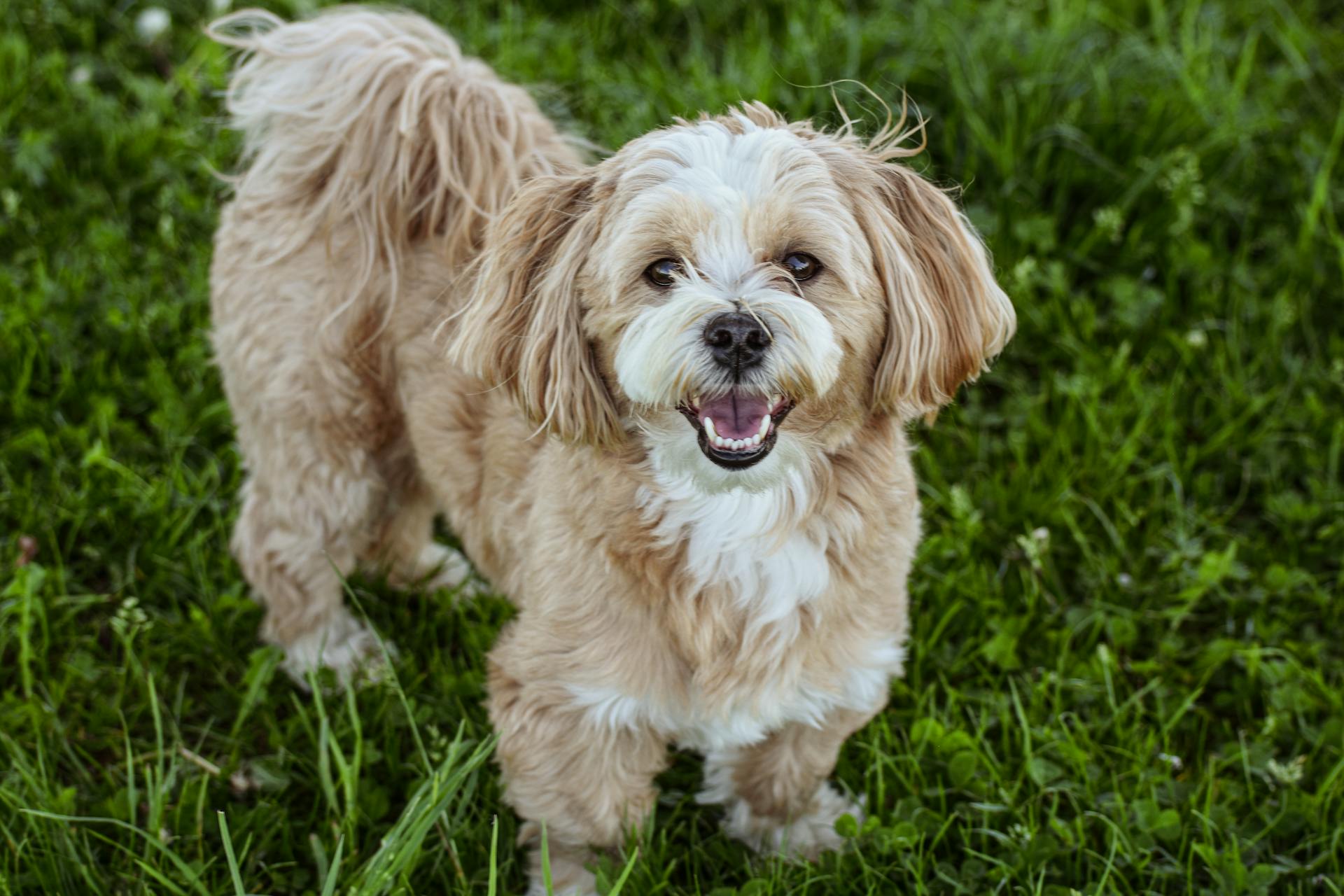
The Lhasa Apso is a small, fluffy dog breed that originated in Tibet, where they were highly valued as temple guard dogs. They're known for their long, flowing coats and their ability to thrive in cold climates.
One of the most distinctive characteristics of the Lhasa Apso is their long, dense coat, which requires regular grooming to prevent matting. They shed heavily, especially during shedding season, so be prepared for regular brushing.
Lhasa Apsos are naturally wary of strangers and can be protective of their family, making them excellent watchdogs. They're also highly intelligent and can be trained with patience and consistency.
Their calm and gentle nature makes them a great companion for families with children, but they do require regular exercise to stay happy and healthy.
Origin and History
The Lhasa Apso is a thousand-year-old breed that has a rich history. They were originally bred as sentinels at palaces and monasteries in the Himalayas of Tibet.
The breed's history is deeply intertwined with Buddhist beliefs, including a belief in reincarnation. They were said to have souls of lamas enter their bodies upon death, giving them added reverence.
The Lhasa Apso was first introduced to the Western world around 1930, with some of the first dogs arriving as gifts from the 13th Dalai Lama. The breed was initially known as the Lhassa Terrier, although it's not a true terrier.
Etymology
The name "Lhasa Apso" has a fascinating history. Lhasa is the capital city of Tibet, and apso is a word from the Tibetan language.
Some people claim that the word "apso" is an anglicized form of the Tibetan word for goatee, which is "ag-tshom" (ཨག་ཚོམ་).
The name may also be a compound noun meaning "bark-guard", which is quite fitting for a dog breed known for its distinctive barking.
You might like: What Is Dog Sledding Called
History
The Lhasa Apso is an ancient breed with a rich history that spans over a thousand years. It originated in the Himalayas of Tibet, where it served as a sentinel at palaces and monasteries.

The breed was first introduced to the Western world in the early 20th century, when some Tibetan dogs were brought to the United Kingdom by military men returning from the Indian subcontinent. These dogs were of mixed types and were collectively known as "Lhasa Terriers".
The first American pair of Lhasas arrived in the United States in 1933 as a gift from the 13th Dalai Lama to C. Suydam Cutting. At the time, there was only one Lhasa Apso registered in England.
The American Kennel Club officially accepted the breed in 1935, initially placing it in the Terrier Group. However, the breed was later transferred to the Non-Sporting Group in 1959.
A different take: Common Dog Types
Physical Characteristics
The Lhasa Apso is a small breed of dog, with dogs standing about 25 cm (9.8 in) tall at the withers and bitches slightly less.
Their coat is thick and heavy, with a hard straight outer coat and a medium under-coat, coming in a variety of colors including black, red, and white.
The Lhasa Apso's ears are pendant, and their tail is curved, sometimes with a kink at the tip, and should be carried over the back.
Size
When it comes to the size of this breed, it's essential to know that ideal height is a crucial factor. Dogs should be around 25cms (10 ins) at the shoulders.
Bitches are slightly smaller than dogs, which is worth noting if you're considering getting one.
Weight
The Lhasa Apso is a small dog, longer than it is tall. This unique physique is a defining characteristic of the breed.
In terms of athleticism, the Lhasa Apso is not built for speed or agility. The breed has strong loin and well-developed quarters and thighs, but it's not suited for high-energy activities.
The head of the Lhasa Apso is well-covered with a good fall over the eyes, giving it a dignified, almost lion-like look. This distinctive facial feature is a result of the breed's well-developed whiskers and beard.
The bite of the Lhasa Apso should be either level or slightly undershot. This specific dental feature is an important consideration for breeders and owners alike.
You might enjoy: Dogs Breeds That Start with B
Information and Pictures
The Lhasa Apso's physical characteristics are truly unique and impressive. They stand about 25 cm (9.8 in) tall at the withers, with bitches slightly less.
Their coat is thick and heavy, with a hard straight outer coat and a medium under-coat. It can come in a variety of colors, including black, red, dark grizzle, golden, honey, parti-colour, sandy, slate-coloured, smoke-coloured, or white.
Their eyes are dark, and their nose is black. Their ears are pendant, which means they hang down to the side of their head.
The Lhasa Apso's tail is curved, sometimes with a kink at the tip, and should be carried over the back. This adorable trait makes them look like a furry little lion.
Despite their small size, they have a long, thick coat that helps them stay warm in freezing temperatures. In fact, they can thrive at elevations of up to 13,000 feet above sea level.
Check this out: Coloured Boston Terrier
Temperament and Personality
The Lhasa Apso is an energetic and very intelligent breed, bred to be watchdogs and companions in Tibetan monasteries. This history led to their being wary of strangers and very protective of their pet parents.
They are also very affectionate with people they know, which makes them excellent companions. Some individuals have a strong prey drive, which could make them difficult for a child or an unsteady adult to walk.
Despite their lapdog appearance, the Lhasa is a tough character, independent and stubborn. They are happy to exercise and play, but also enjoy napping beside their owner.
The Lhasa will be happy as long as given exercise, and they are not excessive barkers. They are somewhat reserved with strangers, but this aloofness can be a good thing in a companion dog.
As a breed, the Lhasa is bold and eager for adventure. They are a great choice for someone who wants a small but spirited companion.
Expand your knowledge: Good Companion Dogs
Frequently Asked Questions
Do Lhasa Apso bark a lot?
Lhasa Apsos are known to bark frequently to alert their owners to potential threats, but their barking is often more of a warning than a defensive action. Their barking is a characteristic trait that can be a consideration for potential owners.
Do Lhasa Apso like to cuddle?
Lhasa Apsos enjoy being close to their owners and often seek cuddles and lap time. However, they may be cautious around new people.
Are Lhasa Apso dogs high maintenance?
Lhasa Apsos have moderate grooming needs, but they are generally considered a low-maintenance breed. Regular grooming is necessary to prevent matting and keep their coat healthy.
What two breeds make a Lhasa Apso?
The Lhasa Apso is a cross between the Tibetan terrier and other herding-type Tibetan dogs. It originated from the Tibetan terrier and similar breeds.
How can I tell if my dog is a Lhasa Apso?
To determine if your dog is a Lhasa Apso, check its size: they typically stand 10-11 inches tall and weigh 12-18 pounds. If your dog matches these dimensions, it may be a Lhasa Apso - learn more about this breed's characteristics and needs.
Featured Images: pexels.com
